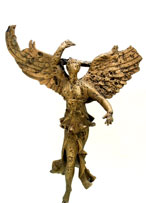| Author | |
|---|---|
| Epoch | XII-XIII |
| Work | The Man in the Panther Skin (Shota Rustaveli, The Man in the Panther Skin, Text and Versions, Edited by Akaki Shanidze and Alexandre Baramidze, Tbilisi, 1966) |
| Type | |
| Quote | “Avtandil, a brave knight, left the place, moving lively. […] He is the joy of the world, he is the matter (literally: thing; in Georgian: ‘Nivti’) and the purpose (literally: debt, i.e., duty; in Georgian: ‘Vali’)“. (Stanza 147, 1/3) |
| Term |

| Comment | The “Thing” (in medieval Georgian: “Nivti”; in ancient Greek: “Hyle”, i.e., “matter”), is a well-known Medieval Georgian philosophical term. But for the numerous interpreters of the passage under discussion (see in details E. Khintibidze, The World View of Rustaveli’s “Vepkhistqaosani” [“The Man in the Panther Skin”], Tbilisi, 2009, pg. 523-527, with bibliography) it was unclear, how could Rustaveli praise Avtandil by means of the “matter” (cf. N. Natadze, Philosophical Motives of “The Man in the Panther Skin”, Tbilisi, 1985, pg. 18). To answer the above-mentioned question, in E. Khintibidze’s view (see op.cit., pg. 522-523, 45-46), it is necessary to be taken into account Aristotle’s famous doctrine on the Four Causes for the Existence, depicted in his “Metaphysics” (I, 3; V, 2; VII, 4) and “Physics” (II, 3), which had been widely spread in scholastics and Neoplatonism during the Middle Ages; correspondingly, it occupies a special place in Ioane Petritsi’s (or Joane Petrizi’s, - Georgian philosopher of 11th-12th centuries) works. Aristotle reveals the four causes for the true existence of each creature and thing: the first is the material (Causa Materialis), the second is the formal (Causa Formalis), the third is the efficient or moving cause (Causa efficiens) and the fourth is the final cause or the purpose (Causa finalis). In the scholastics of the Middle Ages and thus, also in the works of Petritsi, the doctrine was popular in its altered form. Namely, due to one of the main modifications, Aristotle’s fourth final cause, or the cause of the purpose, i.e., objective had been moved to the first place, before the material cause. According to E. Khintibidze (see ibid., pg. 527-534), the Rustavelian “Thing” i.e. “Matter” corresponds with Aristotle’s first, i.e., material cause; and the Rustavelian “Debt” (in Georgian: “Vali”) or “Duty”, i.e., “Objective” matches the cause of the purpose, which is again the first cause, but according to Ioane Petritsi’s classification. Taking into consideration the fact, that in accordance with both Aristotle’s “Physics” (II, 3) and “The Summa Theologica” of Thomas Aquinas, the cause of the purpose is defined as the final objective, i.e., the Goodness, with the words – “Avtandil is the debt, that is, duty”, according to the Medieval scholastics, Rustaveli represents his hero as Kindness or manifestation of kindness. Whatever concerns the “Joy”, i.e. the “Happiness”, with the words – Avtandil is “the joy of the world” Rustaveli declares his hero as the happiness of the earthly world, that is, the supreme purpose of earthly existence. Thus, in accordance with the above-mentioned point of view, “the poet inspired by his hero, to some extent, rises above the medieval philosophy, or scholastics” (see ibid., pg. 528-529; for details see pg. 527-534): 1. Avtandil, as a perfect human being, is a manifestation of earthly happiness (“the joy of the world”), as well as, the final purpose of existence (“debt”/”duty”), i.e., the Kindness. Thus, in the lines under consideration, the reflection of the main concept of Aristotle’s ethical doctrine is revealed (respectively, “Nicomachean Ethics”, I, 2, 7; VIII, 11 and “Physics”, II, 3): a human being, his happiness and bliss are the supreme kindnesses of the Universe, the final purpose of all that exists; 2. Avtandil embodies all kinds of causes of earthly existence, or generally everything, as he is, according to Aristotle’s classification, both the first – the material cause of existence (“Thing” / “Matter”) and the fourth final cause or the purpose of existence (“Dept” / ”Duty”, which is – according to Petritsi’s Neoplatonic classification – again the first, initial cause; see above). Thus, Avtandil, actually, embodies all the four causes of existence. So, in the lines under consideration, the reflection of Aristotle’s metaphysical philosophy of causes for existence and its Neoplatonic and scholastic interpretation are revealed. Thus, the praise of Avtandil’s greatness by Rustaveli – “he is the joy of the world, he is the thing / matter and the debt / duty” – depicts by means of philosophical terminology of the late Middle Ages [“originating from the period of Classical antiquity”] “the fundamental thesis of the Renaissance epoch concerning the human dignity and supremacy: Avtandil is the supreme bliss of the earthly world, he is the cause - both material and final - for existence”. The above mentioned “once again underscores the Renaissance character of Rustaveli’s world view and its typological connection with the European Christian thought of the late Middle Ages and Renaissance” (see ibid., pg. 533). [Z. Kh.] |
|---|

